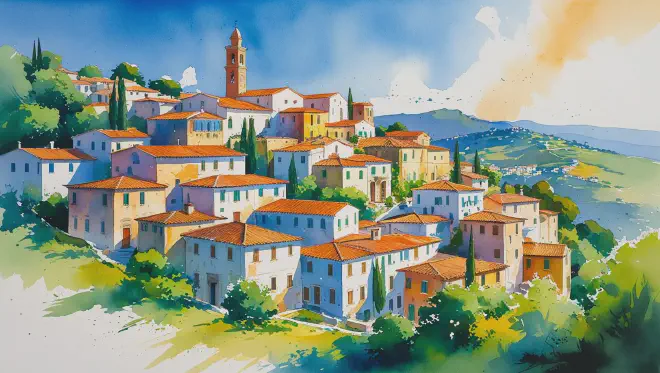Introduction: An Ancient Town Shaped Like a Human
Centuripe is a small commune (municipality) in the Province of Enna, Sicily, Italy, with a population of approximately 5,400 residents. Situated on a ridge at 732 meters above sea level, nestled between the Simeto and Dittaino rivers, this town is renowned for its unique human-like shape when viewed from above.
The ancient Centuripae was recorded by the Greek historian Thucydides as a “city of the Sicels.” It allied with Athens against Syracuse and maintained its independence until it was conquered by Rome during the First Punic War. The archaeological park preserves various ruins from different eras in excellent condition, including Roman baths, a theater, and forum.
I decided to visit this town because I was fascinated by its distinctive topography and the layers of history that span from ancient times to the present. I wanted to see with my own eyes how modern residents live their daily lives in this hilltop town overlooking Mount Etna.

Day 1: Opening the Door to Antiquity
The drive from Catania Airport took about an hour by rental car. The road toward the interior gradually became more undulating, winding through landscapes dotted with olive groves and vineyards. Around 10 AM, I finally caught sight of Centuripe’s silhouette.
What struck me first was that it truly does resemble a human form. The town spreads out like someone lying on the ground, with a head, torso, and legs clearly visible. The locals call this shape “L’Uomo di Centuripe” (The Man of Centuripe).
Driving up the winding road toward the town center, I was immediately drawn to the stone houses. Buildings made of Sicily’s characteristic white limestone gleamed in the morning sunlight. Walking through the narrow alleyways, I encountered elderly men chatting in front of a bar. When I exchanged Italian greetings with them, they welcomed me with warm smiles.
“Buongiorno, turista?” one called out, and I replied in broken Italian, “Sì, giapponese.” They nodded with interest and began telling me about Centuripe’s history. Though I couldn’t understand everything, their gestures and expressions conveyed their deep love for this town.
In the afternoon, I decided to visit the archaeological park. The ruins, located a short distance from the town center, were larger in scale than I had imagined. At the Roman theater ruins, stone seating remained in a semicircular arrangement, and beyond the stage, the majestic Mount Etna was visible. Had people over 2,000 years ago gazed upon this same view?
I sat on the stone steps of the theater for a while, taking in the scenery. With each gust of wind, I could almost hear the cheers of ancient spectators. The intricate carvings remaining on the stone surfaces spoke of the passage of time. When I touched them with my fingers, the cool texture was oddly comforting.
As evening approached, I visited the Chiesa Madre, a church on the town’s high ground. Built in the 17th century, this church features beautiful Baroque decorations. The interior was wrapped in silence, with candlelight casting dancing shadows on the walls. Watching the local people offering their prayers, I understood how precious faith was to the people of this town.
For dinner, I ate at a small trattoria in town. The owner, Signora Rosalia, spoke to me in Sicilian-accented Italian. While she explained the menu, I ordered pasta alla norma and arancini. The pasta was a perfect blend of eggplant, tomato, and ricotta salata, while the arancini had a crispy exterior and creamy risotto interior that was absolutely delicious.
After the meal, Signora Rosalia sat beside me and shared stories about old Centuripe. Her grandfather had been born and raised in this town, spending his entire life here without ever leaving. “This town is small, but everything is here,” she said. I didn’t yet fully understand the meaning of those words.
I stayed at a small B&B in the town center. From my room’s window, I could see Mount Etna’s silhouette illuminated by moonlight. In the silence, I could hear church bells ringing in the distance. Looking at my watch, it was past 11 PM. I fell asleep to the sound of wind echoing through the old stone buildings, planning to explore this town’s charms more deeply tomorrow.
Day 2: Mountain Blessings and People’s Lives
I woke around 6 AM to the sound of church bells. Opening the window, I breathed in the cool air, accompanied by the scents of olive oil and bread. The B&B breakfast consisted of freshly baked bread from the local bakery, homemade marmalade, and aromatic espresso.
I spent the morning exploring the town’s surroundings. On the hill corresponding to the “head” of the human shape stood the ruins of an old castle. Though called Corradino’s Castle, it’s actually a Roman mausoleum. The stone structure still conveyed its former grandeur.
The view from the castle ruins was magnificent. Below spread a beautiful patchwork of olive groves and vineyards. In the distance, Mount Etna towered majestically, its peak capped with snow. The inland Sicilian landscape was much greener than I had imagined, offering a sense of seasonal change.
During my walk, I met a local farmer. Giuseppe, a man in his sixties, has been cultivating olives and grapes on this land for generations. He guided me to his fields and showed me olive fruits in his hand. “These are our treasures,” he said. The olives were small but deep green, and when I held them, I could feel their weight.
I spent the afternoon strolling slowly through the town center. On this weekday afternoon, the town was quiet. When children began returning from school, the town suddenly came alive. In the small square, grandmothers gathered for gossip while children kicked soccer balls nearby.
At a small shop in one corner of the square, I discovered local specialties. Almond sweets made from Sicilian almonds and honey made with herbs unique to this region were displayed. The elderly shopkeeper explained each product in detail. The almond sweets I tasted were simple yet deeply flavorful.
As evening approached, townspeople emerged for their walks. This is the Italian custom called “passeggiata.” Families, friends, and couples strolled slowly along the main street. I joined them in their walk. The people I passed greeted me warmly, despite being a stranger and tourist.
I returned to the trattoria for dinner. This time it was bustling with locals. While I hesitated over the menu, a family at the neighboring table recommended, “Try the caponata.” This Sicilian ratatouille-like dish features eggplant, tomatoes, celery, and olives slowly simmered together. The sweet and sour seasoning paired perfectly with bread.
After dinner, I had the opportunity to speak with Maria, a local teacher who was also dining at the trattoria. She had been teaching at the town’s elementary school for 30 years and had witnessed Centuripe’s changes. “Young people often leave for urban areas, but some understand the goodness of this town,” she said.
According to Maria, more people have been moving here from urban areas in recent years. They’re attracted to Centuripe’s peaceful environment and the warmth of its people. “Because it’s a small town, everyone can build family-like relationships,” she smiled.
On my way back to the accommodation, I gazed up at the night sky. Unlike in urban areas, the stars were clearly visible here. I could even make out the Milky Way distinctly. This beautiful starry sky was the same one ancient people had gazed upon. The sense of connection across time warmed my heart.
Day 3: A Memorable Farewell
I greeted the final morning with a touch of sadness. Over breakfast at the B&B, I spoke with the owner, Signora Anna. She mentioned that Japanese tourists visiting Centuripe were rare. “But I’m happy that people like you understand this town’s charm,” she said, giving me homemade almond cookies to take with me.
I set out for one last walk. I explored the area corresponding to the “legs” of the human shape. Residential neighborhoods spread out here, with laundry swaying in the breeze—a heartwarming sight. There were houses with tomatoes growing in their yards, terraces where grandfathers read newspapers, and homes where children played. Every house radiated the warmth of daily life.
I encountered an elderly woman selling vegetables by the roadside. Fresh vegetables from her garden were beautifully arranged in baskets: tomatoes, zucchini, eggplant, and peppers. All were vibrantly colored, reflecting the sun’s blessings. “Buello, buello (delicious, delicious),” she said, picking up a tomato and offering it to me.
When I bit into that tomato, the perfect balance of sweetness and acidity was exquisite—more delicious than any tomato I had ever tasted. It seemed to contain the fragrance of soil, the taste of sunshine, and the maker’s love.
I spent lunch at a small pizzeria in the town center. The pizza margherita baked in a stone oven was simple yet perfect. I was amazed that such delicious pizza could be made with just the basic ingredients of tomato sauce, mozzarella cheese, and basil.
After the meal, I visited the archaeological park one final time. Gazing at the Roman ruins, I reflected on these three days. The warmth of the people I met in the small town of Centuripe, the beautiful scenery, the delicious food, and the history that continues across time—all were deeply etched in my heart.
Sitting on the theater’s stone steps, looking out at Mount Etna, I felt I could hear the voices of ancient people. They too had gazed upon this mountain, loved this land, and lived their lives here. Perhaps while times change, the essential nature of human life remains constant.
Around 3 PM, I left Centuripe. Looking down at the town from the hill, I could clearly see its human shape. It looked like a giant lying on the earth. This giant has been sleeping quietly here for centuries.
On the road to Catania Airport, the scenery visible through the car window looked different than when I had arrived. What had been merely rural landscape three days ago now seemed to hold stories in each field. Every house probably contained the daily lives, history, and love of the people who lived there.
While completing check-in procedures at the airport, I ate the almond cookies Signora Anna had given me. As the sweet taste spread in my mouth, memories of Centuripe vividly returned. I would never forget this taste.
When the plane took off, I could see the Sicilian landscape from the window. In the green, rolling hills of the interior, Centuripe appeared as a small dot. In that human-shaped town, people were still living their daily lives. This thought warmed my heart.
Conclusion: What Felt Real Despite Being Imaginary
This 2-night, 3-day journey to Centuripe was an imaginary trip I haven’t actually experienced. However, while researching this town and expanding my imagination, I felt as though I had truly visited there.
This ancient town, situated on a ridge 732 meters above sea level, has the unique characteristic of resembling a human form when viewed from above. Roman ruins are preserved in excellent condition, with remains of theaters, baths, and forums still visible.
The warmth of the people I met in my imagination, the beautiful stone buildings, the magnificent landscape overlooking Mount Etna, and the weight of history continuing from ancient times to the present—all of these are etched in my mind as certain memories.
Perhaps travel doesn’t necessarily mean only physically visiting a place. By exercising imagination and thinking deeply about a land’s history, culture, and people’s lives, we can create new landscapes in our hearts. This too might be one form of travel.
Through this imaginary journey to the small town of Centuripe, I was able to discover Italy’s charm from a new perspective. If I ever have the opportunity to actually visit this town, I’m sure I’ll encounter the same warmth and beauty I felt in my imagination.

